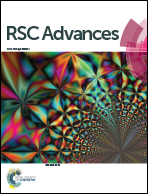Can microwave assisted in situ reduction of supported Pt nanoparticles challenge the chemical method in controlling the dispersion profile-catalytic performance relationship?†
Abstract
In this study, Pt (of 0.3, 0.6 and 0.9 wt% loadings) was supported on a mesoporous silica surface via a microwave-assisted solution (MAS) method or rotary chemical evaporation (RCE) method in the in situ reduction step. The as-synthesized Pt nanocatalysts were characterized through XRD, XRF, TGA/DSC, TEM, N2-adsorption–desorption, H2-pulse titration and electrical conductivity techniques. The samples prepared by MAS method exhibited higher surface area and a better dispersion profile of Pt NPs, of average sizes not exceeding 10 nm with increasing the Pt loading. In contrast, although RCE method showed higher efficacy in decomposing the used precursor, an uneven distribution of larger Pt nanoparticles (≥33 nm) was determined. Electrical properties in terms of AC conductivity and dielectric constant confirmed the enhancement of an even distribution of smaller Pt NPs with a higher concentration of grain boundaries effected by microwave electromagnetic radiations. Highly mobile electrons and lattice vibrations (phonons) were favored, as compared with aggregated NPs produced during RCE method. The TOF values calculated for reactions to selectively produce ethylene (from ethanol) or benzene (from cyclohexane) decreased with Pt loading on the catalyst samples synthesized by MAS method. The highly dispersed NPs (of 3–7 nm) seemed to be responsible for the activity in both reactions, probably tending to be structure insensitive. However, samples reduced by RCE method, with enlarged average sizes of surface Pt NPs (approaching 15.5 nm), exhibited increasing TOF values with Pt loading, i.e., causing the reactions most probably to be structure sensitive.


 Please wait while we load your content...
Please wait while we load your content...